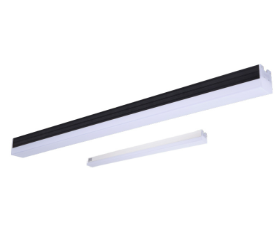How to choose LED linear light?
2025-03-07
Nowadays, children sit for hours while reading and doing homework, so some table lamps that focus on "eye protection" and "anti-myopia" are also favored by parents, but how to choose LED linear lamps?
Eye protection lamps usually refer to reading lamps. Its professional name is reading and writing table lamps or visual table lamps.
In order to take into account the use during the day and at night, it is recommended to choose table lamps with controllable color temperature. The color temperature range is between 3300K and 5300K. The light is soft and comfortable, which can reduce eye fatigue.
Nowadays, there is also a saying on the Internet that the degree of light flickering can be tested by mobile phone cameras to judge the quality of LED linear lamps. Experts said that this light flickering phenomenon is called stroboscopic, also known as fluctuation depth. Under AC voltage, almost all table lamps will flicker, but the degree is different.
"No flicker" in the absolute sense is impossible. At present, most LED linear lamps on the market use LED light sources, and their operating voltage frequency is greatly improved compared with traditional light sources, making it impossible for the naked eye to distinguish flicker. However, even if the naked eye and mobile phone cannot see it, it does not mean that the flicker does not exist, so the method of measuring flicker with a mobile phone is unscientific. It is recommended to select the flicker (parameter) with no significant impact level or the flicker parameter 3125 Hz and above.
When choosing LED linear lights, you need to pay attention to the following parameters:
1. Illuminance and illumination uniformity
Illuminance, in simple terms, is whether the light of the desk lamp is bright enough on the desktop. The unit is lux (lx). The larger the value, the brighter it is.
Illuminance uniformity is the ratio of the maximum illumination to the minimum illumination in the effective working area. The smaller the value, the more uniform the light from the desk lamp to the desktop or work surface.
According to the standard requirements, the AA-level desk lamp has higher requirements for illumination and illumination uniformity than the A-level, that is, the light of the AA-level desk lamp is brighter and the illumination is more uniform. When purchasing, you can give priority to the AA-level.
2. Color rendering index
The color rendering index represents the ability of the desk lamp to restore color. Generally speaking, the higher the color rendering index, the closer the color of the object under this type of light is to the real color. The national standard stipulates that the general color rendering index Ra of reading and writing desk lamps should not be less than 80. For products with LED light sources, their special color rendering index R9 should be greater than 0.
3. Color temperature
Color temperature can be simply understood as the color of light. K is its unit. The smaller the value, the warmer the light color (yellow); the larger the value, the colder the light color (white).
Light with a color temperature range of about 4000K~5000K presents a natural white color, which is closer to natural light and more suitable for daytime use. Light with a color temperature below 4000K presents a warm white or yellow color, which is softer and more suitable for nighttime use. In order to take into account both daytime and nighttime use, it is recommended to choose a desk lamp with adjustable color temperature, with a color temperature range of 3300K~5300K.
In addition, it is recommended that children and adolescents adjust the color temperature of the light to below 4000K when using a reading and writing desk lamp at night.
4. Retinal blue light hazard
The definition of retinal blue light hazard level is derived from IEC TR 62778:2014. The blue light weighted radiance (LB) limit obtained from the test determines different hazard levels and duration of hazard. The presence of blue light in the lamp does not mean that blue light hazard will occur. In order to prevent excessive blue light from damaging the eyes of children and adolescents during their learning process, the standard requires that the blue light hazard group of LED linear lamps should be RG0.


